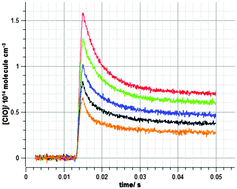Kinetics of the ClO + HO2 reaction over the temperature range T = 210–298 K
Abstract
The rate coefficient for the atmospherically important radical reaction:

* Corresponding authors
a Laboratoire PC2A/CNRS, Université de Lille 1, Villeneuve d'Ascq, France
b
Department of Chemistry, UCL, 20 Gordon Street, London WC1H 0AJ, UK
E-mail:
d.m.rowley@ucl.ac.uk
The rate coefficient for the atmospherically important radical reaction:

 Please wait while we load your content...
Something went wrong. Try again?
Please wait while we load your content...
Something went wrong. Try again?
M. K. M. Ward and D. M. Rowley, Phys. Chem. Chem. Phys., 2016, 18, 6301 DOI: 10.1039/C5CP07329D
To request permission to reproduce material from this article, please go to the Copyright Clearance Center request page.
If you are an author contributing to an RSC publication, you do not need to request permission provided correct acknowledgement is given.
If you are the author of this article, you do not need to request permission to reproduce figures and diagrams provided correct acknowledgement is given. If you want to reproduce the whole article in a third-party publication (excluding your thesis/dissertation for which permission is not required) please go to the Copyright Clearance Center request page.
Read more about how to correctly acknowledge RSC content.
 Fetching data from CrossRef.
Fetching data from CrossRef.
This may take some time to load.
Loading related content
